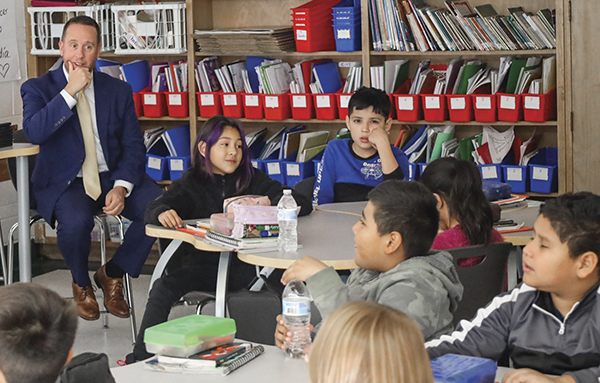Harvard District Promotes Dual Languages as Equity Asset
January 01, 2023

AASA Learning 2025 Lighthouse Demonstration System: Harvard Community Unit School District 50
For the past 15 years, the Harvard Community Unit School District 50, located about 70 miles northwest of Chicago near the Wisconsin border, has offered a dual-language immersion program for its students.
From its modest start of 56 students in two 1st-grade classes, the dual language program now enrolls about 60 percent of the district’s 2,600 students in five schools. There are 1,174 students enrolled in pre-K through 8th grade, with 397 students taking language classes in high school.
Upwards of 40 percent of families use Spanish as their first language. Slightly more than half of the kindergarten families this year are native Spanish speakers.
Unlike traditional English language learner programs, Harvard CUSD 50’s dual language program is not about moving these students to English-only classes. Being a native Spanish speaker is not seen as a deficit on the way to acquiring English proficiency. Rather, becoming proficient in two languages is viewed as an asset.
Seals of Approval
This approach is why AASA selected the district as a Lighthouse model in its Learning 2025 initiative. This status recognizes Harvard’s commitment, as the district application to become a demonstration district states, “to serving all families who value the benefits of being bilingual, biliterate and bicultural. … [T]he district has persisted in its belief in the importance of dual language education for all students.”

Harvard’s leadership is determined that more than 50 percent of its students will earn the Illinois Seal of Biliteracy, reflecting proficiency in two languages.
The initial motivation to launch the program, says district superintendent Corey Tafoya, was “a sense of an inferiority complex. … There was a sense that ‘this is good enough for Harvard, we’ll survive.’ We were settling for not high quality, and the kids were ready for higher expectations.”
Long a destination for outward-migrating Chicago families, the community is culturally and linguistically diverse, Tafoya says. So Harvard CUSD 50 approaches this work through a perspective of “cultural and linguistic equity … where everyone is welcomed and valued.”
Homage to Heritage
The superintendent understands parents these issues on a personal level. Tafoya grew up in an English-speaking home, although he heard Spanish from his grandfather, a Mexican who lived most of his adult life in Colorado. Tafoya’s father, like so many others of his generation, was compelled as part of becoming an American citizen to avoid learning or speaking his native language.
“I learned to understand Spanish from being around [my grandfather], but my own Spanish is school-based primarily,” he adds.
The superintendent says he fully appreciates the desires of parents to have their children “retain fluency and competency. … Too often you forget your native tongue.”
The district makes it work like this: Students receive 200 minutes of instruction in English language arts and 200 minutes in Spanish language arts over a school week. Some subjects may be taught in either language.
Tafoya and his staff recognize that acquiring facility and fluency in both languages can be challenging.
Everything from letters sent home to parents and signage in schools are offered in English and Spanish. Some extracurricular activities, such as theater, are offered in both languages.
“We have to remind people that a language deficit is not an intellectual issue,” says Tafoya. “Let’s build a Spanish-language brain, nurturing both languages.”
The library offers titles in Spanish and English, with texts that reflect a “representation of cultures,” the superintendent adds. The district also offers dual-language family nights at its five schools.
Community Commitment
Amber Bowgren, director of language and cultural education for Harvard CUSD 50, says the district’s commitment to engaging with the community has helped grow the dual language program.
A Bilingual Parent Advisory Committee livestreams its meetings on Facebook, using Title 3 funds to offer a digital literacy class in Spanish for families. “Our bilateral families don’t have technical skills to move through the school’s student information systems,” Bowgren says.
Weekly language classes are available for families who want to learn English or Spanish. Families who are unfamiliar with the American system learn about “how credits are earned, graduation requirements, electives, extracurriculars, the logistics of being a student and how to apply for FAFSA,” she says.
“These programs are funded through the budget, which demonstrates the district’s commitment to bilingualism and biculturalism,” Bowgren says.
To meet staffing needs, the district recruits from Spain, Puerto Rico, Mexico and Argentina and works with state government to secure work visas. And to ensure a pipeline of bilingual educators, the district has applied for federal Bilingual Educator Pathway funding for the coursework and licensing requirements for these staff members.
The superintendent emphasizes his district’s approach is about keeping Spanish-speaking families from living in a silo.
“They’re trying to assimilate, they want to know these things,” says Tafoya, pointing out that the Pledge of Allegiance is recited by students or read by an administrator in Spanish in those schools that do the pledge, as part of the process of “how to become and hold these American values.”
Merri Rosenberg is a freelance education writer in Ardsley, N.Y.
Author
Advertisement
Advertisement
Advertisement
Advertisement



